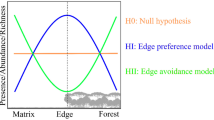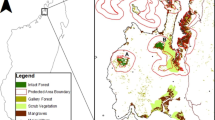Abstract
Endozochorous seed dispersal by herbivores can affect plant spatial dynamics and macroecological patterns. We have investigated the number and species composition of viable seeds deposited in faeces of a full guild of macroherbivores (four deer and two lagomorph species) in a forest in eastern Britain. One hundred and one plant species germinated from faecal pellet material, 85 of which were among the 247 vascular plant species recorded in the forest. However, three species – Chenopodium album, Urtica dioica and Agrostis stolonifera – comprised 56% of the seedlings recorded. Of the species recorded in faecal samples, 36% had no recognised dispersal mechanism, while very few (7%) were adapted to endozoochorous dispersal (fleshy fruit or nut). The number of species dispersed by the herbivores was ranked Cervus elaphus and Dama dama (96) > Capreolus capreolus (40) > Muntiacus reevesi (31) > Oryctolagus cuniculus (21) > Lepus europaeus (19), with the other taxa dispersing subsets of those dispersed by C. elpahus and D. dama. The invasive M. reevesi deposited the fewest seeds per gram of faecal pellet material (0.4 g−1) and hence fewer seeds per unit area than other deer species despite their numerical dominance, while C. elaphus/D. dama deposited the most (0.43 seeds m−2 year−1). Due to differences in faecal seed density among habitats combined with the ranging behaviour of animals, more seeds were deposited in younger stands, enhancing the potential contribution of macroherbivores to population persistence by dispersal and colonisation in a successional mosaic.



Similar content being viewed by others
References
ADAS (ADAS Holding) (1997) Biological monitoring of arable field margins in the Breckland ESA 1989–1996. ADAS Report to UK Ministry of Agriculture, Fisheries and Food (MAFF)
Bourgeois K, Suehs CM, Vidal E, Medail F (2005) Invasional meltdown potential: facilitation between introduced plants and mammals on French Mediterranean islands. Ecoscience 12:248–256
Bruinderink GG, Van Der Sluis T, Lammertsma D, Opdam P, Pouwels R (2003) Designing a coherent ecological network for large mammals in northwestern Europe. Conserv Biol 17:549–557
Bruun HH, Poschlod P (2006) Why are small seeds dispersed through animal guts: large numbers or seed size per se? Oikos 113:402–411
Chao A (1987) Estimating the population size for capture–recapture data with unequal catchability. Biometrics 43:783–791
Chapman NG (2004) Faecal pellets of Reeves’ muntjac, Muntiacus reevesi: Defecation rate, decomposition period, size and weight. Eur J Wildl Res 50:141–145
Chapman NG, Claydon K, Claydon M, Forde PG, Harris S (1993) Sympatric populations of muntjac (Muntiacus reevesi) and roe deer (Capreolus capreolus): a comparative analysis of their ranging behaviour, social organization and activity. J Zool 229:623–640
Chiarucci A, Enright NJ, Perry GLW, Miller BP, Lamont BB (2003) Performance of nonparametric species richness estimators in a high diversity plant community. Divers Distrib 9:283–295
Clarke GDP, Warwick RM (2005) Primer 6 (plymouth routines in multivariate ecological research). Primer-E, Plymouth
Colwell RK (2005) Estimates: statistical estimation of species richness and shared species from samples. Version 7.5. User’s Guide and application published at: http://www.purl.oclc.org/estimates
Constible JM, Sweitzer RA, Van Vuren DH, Schuyler PT, Knapp DA (2005) Dispersal of non-native plants by introduced bison in an island ecosystem. Biol Invas 7:699–709
Cosyns E, Hoffmann M (2005) Horse dung germinable seed content in relation to plant species abundance, diet composition and seed characteristics. Basic Appl Ecol 6:11–24
Cosyns E, Delporte A, Lens L, Hoffmann M (2005) Germination success of temperate grassland species after passage through ungulate and rabbit guts. J Ecol 93:353–361
Cote SD, Rooney TP, Tremblay JP, Dussault C, Waller DM (2004) Ecological impacts of deer overabundance. Annu Rev Ecol Evol Syst 35:113–147
Dolman PM, Sutherland WJ (1992) Ecological changes of Breckland grass heaths and consequences of management. J Appl Ecol 20:402–413
Dunn O (1964) Multiple contrasts using rank sums. Technometrics 6:241–252
Eldridge DJ, Simpson R (2002) Rabbit (Oryctolagus cuniculus L.) impacts on vegetation and soils, and implications for management of wooded rangelands. Basic Appl Ecol 3:19–29
Eycott AE (2005) Plant population and community processes in a forested landscape. Unpublished PhD thesis. University of East Anglia, Norwich
Eycott AE, Watkinson AR, Dolman PM (2006a) Ecological patterns of plant diversity in a plantation forest managed by clearfelling. J Appl Ecol 43:1161–1171
Eycott AE, Watkinson AR, Dolman PM (2006b) The soil seedbank of a lowland conifer forest: the impacts of clear-fell management and implications for heathland restoration. For Ecol Manage 237:280–289
Fitter AH, Peat HJ (1994) The ecological flora database. J Ecol 82:415–425
Flux JEC (1970) Life history of mountain hare (Lepus timidus scoticus) in north-east Scotland. J Zool 161:75–123
Freckleton RP, Gill JA, Noble D, Watkinson AR (2005) Large scale population dynamics, abundance-occupancy relationships and the scaling from local to regional population size. J Anim Ecol 74:353–364
Fuller RJ, Gill RMA (2001) Ecological impacts of increasing numbers of deer in British woodland. Forestry 74:193–200
Gordon IJ (2003) Browsing and grazing ruminants: are they different beasts? For Ecol Manage 181:13–21
Grime JP, Hodgson JG, Hunt R (1988) Comparative plant ecology. Unwin Hyman, London
Harper JL (1977) The population biology of plants. Academic, London
Harris S, Forde P (1986) The annual diet of muntjac (Muntiacus reevesi) in the King’s Forest, Suffolk. Bull Br Ecol Soc 17:19–22
Hearney AW, Jennings TJ (1983) Annual foods of the red deer (Cervus elaphus) and the roe deer (Capreolus capreolus) in the east of England. J Zool 201:565–570
Heinken T, Hanspach H, Schaumann F (2001) Welche Rolle spielt die endozoochore Ausbreitung von Pflanzen durch wildlebende Säugetiere? (How important is endozoochorous seed dispersal by wild mammals in central European forests?). Hercynia N F 34:237–259
Heinken T, Hanspach H, Raudnitschka D, Schaumann F (2002) Dispersal of vascular plants by four species of wild mammals in a deciduous forest in NE Germany. Phytocoenologia 32:627–643
Hemami MR, Watkinson AR, Dolman PM (2004) Habitat selection by sympatric muntjac (Muntiacus reevesi) and roe deer (Capreolus capreolus) in a lowland commercial pine forest. For Ecol Manage 194:49–60
Hemami MR, Watkinson AR, Dolman PM (2005) Population densities and habitat associations of introduced muntjac Muntiacus reevesi and native roe deer Capreolus capreolus in a lowland pine forest. For Ecol Manage 215:224–238
Holter P (2000) Particle feeding in Aphodius dung beetles (Scarabaeidae): old hypotheses and new experimental evidence. Funct Ecol 14:631–637
Holter P, Scholtz CH, Wardhaugh KG (2002) Dung feeding in adult scarabaeines (tunnellers and endocoprids): even large dung beetles eat small particles. Ecol Entomol 27:169–176
Hulbert IAR, Iason GR, Racey PA (1996) Habitat utilization in a stratified upland landscape by two lagomorphs with different feeding strategies. J Appl Ecol 33:315–324
Janzen DH (1984) Dispersal of small seeds by big herbivores: foliage is the fruit. Am Nat 123:338–353
Kolb HH (1991) Use of burrows and movements of wild rabbits (Oryctolagus cuniculus) in an area of hill grazing and forestry. J Appl Ecol 28:892–905
Kuijper DPJ, Wieren SE, Bakker JP (2004) Digestive strategies in two sympatrically occurring lagomorphs. J Zool 264:171–178
Legendre P, Legendre L (1998) Numerical ecology, second English edn. Elsevier, Amsterdam
Lockley RM (1962) Production of faecal pellets in wild rabbit. Nature 194:988–989
Malo JE, Suarez F (1995a) Establishment of pasture species on cattle dung: the role of endozoochorous seeds. J Veg Sci 6:169–174
Malo JE, Suarez F (1995b) Herbivorous mammals as seed dispersers in a Mediterranean dehesa. Oecologia 104:246–255
Malo JE, Jiminez B, Suarez F (1995) Seed pool build up in small disturbances in a Mediterranean pasture: the contribution of endozoochorous dispersal by rabbits. Ecography 18:73–82
Mayle BA, Doney J, Lazarus G, Peace AJ, Smith DE (1996) Fallow deer (Dama dama L.) defecation rate and its use in determining population size. Suppl Ricerche Biol Selvaggina 25
Mitchell B, McCowan D (1984) The defecation frequencies of red deer in different habitats. In: Annual report of the Institute of Terrestrial Ecology 1983. Institute of Terrestrial Ecology, Cambridge, UK, pp 15–17
Mitchell B, Rowe JJ, Ratcliffe P, Hinge M (1985) Defecation frequency in Roe deer (Capreolus capreolus) in relation to the accumulation rates of faecal deposits. J Zool 207:1–7
Mouissie AM (2004) Seed dispersal by large herbivores: implications for the restoration of plant biodiversity. PhD thesis. University of Groningen, Groningen, the Netherlands
Mouissie AM, Vos P, Verhagen HMC, Bakker JP (2005) Endozoochory by free-ranging, large herbivores: ecological correlates and perspectives for restoration. Basic Appl Ecol 6:547–558
Myers JA, Vellend M, Gardescu S, Marks PL (2004) Seed dispersal by white-tailed deer: implications for long-distance dispersal, invasion, and migration of plants in eastern north America. Oecologia 139:35–44
Nchanji AC, Plumptre AJ (2003) Seed germination and early seedling establishment of some elephant-dispersed species in Banyang-Mbo Wildlife Sanctuary, south-western Cameroon. J Trop Ecol 19:229–237
Pakeman RJ (2001) Plant migration rates and seed dispersal mechanisms. J Biogeogr 28:795–800
Pakeman RJ, Attwood JP, Engelen J (1998) Sources of plants colonising experimentally disturbed patches in an acidic grassland, in eastern England. J Ecol 86:1302–1041
Pakeman RJ, Engelen J, Attwood JP (1999) Rabbit endozoochory and seedbank build-up in an acidic grassland. Plant Ecol 145:83–90
Pakeman RJ, Digneffe G, Small JL (2002) Ecological correlates of endozoochory by herbivores. Funct Ecol 16:296–304
Salisbury E (1961) Weeds and aliens. Collins, London
Schmidt M, Sommer K, Kriebitzsch WU, Ellenberg H, von Oheimb G (2004) Dispersal of vascular plants by game in northern Germany. Part I: Roe deer (Capreolus capreolus) and wild boar (Sus scrofa). Eur J For Res 123:167–176
Stace C (1997) New flora of the British Isles, 2nd edn. Cambridge University Press, Cambridge
Taylor RH, Williams RM (1956) The use of pellet counts for estimating the density of populations of the wild rabbit, Oryctolagus cuniculus. N Z J Sci Technol 38:236–256
Thompson K, Bakker JP, Bekker RM (1997) The soil seed pools of north west Europe: methodology, density and longevity, 1st edn. Cambridge University Press, Cambridge
Trist PJO (1979) An ecological flora of Breckland. EP Publ, Wakefield
Vellend M, Myers JA, Gardescu S, Marks PL (2003) Dispersal of Trillium seeds by deer: implications for long distance migration of forest herbs. Ecology 84:1067–1072
von Oheimb G, Schmidt M, Kriebitzsch WU, Ellenberg H (2005) Dispersal of vascular plants by game in northern Germany. Part II: Red deer (Cervus elaphus). Eur J For Res 124:55–65
Walther BA, Morand S (1998) Comparative performance of species richness estimation methods. Parasitology 116:395–405
Watt AS (1981) A comparison of grazed and ungrazed grassland in East Anglian Breckland. J Ecol 69:499–508
Welch D (1985) Studies in the grazing of heather moorland in north-east Scotland iv. Seed dispersal and plant establishment in dung. J Appl Ecol 22:461–472
Zedler PH, Black C (1992) Seed dispersal by a generalized herbivore: rabbits as dispersal vectors in a semi-arid California vernal pool landscape. Am Midl Nat 128:1–10
Acknowledgements
We thank the Forestry Commission for permission to work in Thetford Forest and ranger data, ADAS for the arable weed data and Norfolk Wildlife Trust for Wayland Wood data. We are also grateful to two anonymous reviewers who suggested useful improvements. AEE was funded by NERC (award no. NER/S/A/2000/03322) and is grateful to a number of people for assistance in the field. This work was carried out in accordance with the laws of the United Kingdom.
Author information
Authors and Affiliations
Corresponding author
Additional information
Communicated by Peter Clarke.
Electronic supplementary material
Below is the link to the electronic supplementary material.
Rights and permissions
About this article
Cite this article
Eycott, A.E., Watkinson, A.R., Hemami, MR. et al. The dispersal of vascular plants in a forest mosaic by a guild of mammalian herbivores. Oecologia 154, 107–118 (2007). https://doi.org/10.1007/s00442-007-0812-1
Received:
Accepted:
Published:
Issue Date:
DOI: https://doi.org/10.1007/s00442-007-0812-1




